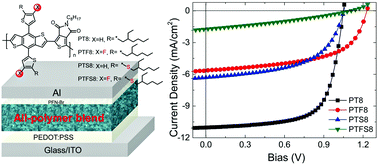Understanding the impact of side-chains on photovoltaic performance in efficient all-polymer solar cells†
Abstract
In order to understand the impact of side-chains on photovoltaic performance and explore efficient all-polymer solar cells, chemical modifications on donor–acceptor based polymers containing benzo[1,2-b:4,5-b′]dithiophene (BDT) and thieno[3,4-c]pyrrole-4,6-dione (TPD) backbones were performed. Via side-chain fluorination, the molecular design resulted in lower highest occupied molecular orbital (HOMO) energy levels and enhanced backbone planarity. The intermolecular packing and solid-state ordering were found to significantly improve. These factors are considered as key influences for carrier transport. In contrast, introducing a bulky alkylthio substituent group was found to slightly distort the polymer backbone. As a result of the lower HOMO level, PTF8 exhibits an improved open circuit voltage (Voc) compared to the template polymer PT8. However, due to the increased crystallinity and aggregation, PTF8 and PTS8 experience an unfavorable phase separation in polymer–polymer bulk heterojunction blends, hindering the PCE to about 4%. Through the introduction of alkylthio side-chains and fluorination, the polymer PTFS8 exhibits an extremely low HOMO level (−5.73 eV). This reduced HOMO level limits charge separation between the donor and acceptor polymers. Without any fluorination and alkylthio side-chains, the wide bandgap polymer PT8 exhibits desired HOMO energy levels and crystallinity, delivering a best PCE of 8% together with a high Voc of 1.05 V, displaying its great potential for applications in efficient all-polymer optoelectronic devices.



 Please wait while we load your content...
Please wait while we load your content...